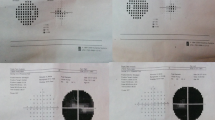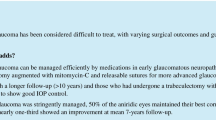Abstract
Purpose
To compare outcome of 4 methods for management of angle closure neovascular glaucoma (NVG) in diabetic eyes.
Methods
Prospective comparative study, on 40 eyes (40 patients) with NVG. Patients were randomly assigned to group A (Trabeculectomy with MMC), B (Ahmed valve), C (Ex-Press Minishunt with MMC) or D (Diode cyclophotocoagulation). Patients were followed regularly for 1 year. Main outcome measures: intraocular pressure (IOP), best corrected visual acuity (BCVA), central foveal thickness (CFT), intraoperative bleeding, postoperative complications and 2ry intervention.
Results
Preoperative data were not significantly different between 4 groups. Postoperatively, there was significant drop in IOP in each group at each follow-up. Ahmed valve group showed least mean postoperative IOP and highest mean drop of the IOP at 1 day and 1 week postoperatively, while Ex-Press minishunt group had least mean postoperative IOP at 1 month and 3 months postoperatively. At 6 months and 1 year, there was no significant difference between 4 groups. BCVA was not significantly different between 4 groups. At 1 year, CFT was significantly lower in each of the 4 groups, and it was significantly the least in group A and highest in group D. Highest intraoperative bleeding was observed with trabeculectomy. Success rate was not significantly different among the 4 groups.
Conclusion
The 4 management options showed a significant long-term effect on IOP, and on long-terms there was no significant difference between them for IOP and BCVA. Trabeculectomy showed highest incidence of intraoperative bleeding, while cyclophotocoagulation showed none.


Similar content being viewed by others

Data availability
No data set associated with this submission.
References
Albert DM, Jakobiec FA (1999) Neovascular Glaucoma. In: Albert DM, Jakobiec FA (eds) Principles and practice of ophthalmology. WB Saunders Publishers, Philadelphia
Shazly TA, Latina MA (2009) Neovascular glaucoma: etiology, diagnosis and prognosis. Semin Ophthalmol 24(2):113–121
Hayreh SS (2007) Neovascular glaucoma. Prog Retin Eye Res 26(5):470–485
Fernandez-Vigo J, Castro J, Macarro A (1997) Diabetic iris neovascularization. Natural history and treatment. Acta Ophthalmol Scand 75(1):89–93
Rodrigues GB, Abe RY, Zangalli C et al (2016) Neovascular glaucoma: a review. Int J Retin Vit 2:26
Yilmaz SG, Yildirim S, Degirmenci C et al (2016) Evaluation of Ex-PRESS mini glaucoma shunt implantation with preoperative intracameral bevacizumab injection in refractory neovascular glaucoma. European J Ophthalmol 26(6):511–646
Park SC, Su D, Tello C (2012) Anti-VEGF therapy for the treatment of glaucoma: a focus on ranibizumab and bevacizumab. Expert Opin Biol Ther 12(12):1641–1647
Wang JW, Zhou MW, Zhang X et al (2014) Short-term effect of intravitreal ranibizumab on intraocular concentrations of vascular endothelial growth factor-A and pigment epithelium-derived factor in neovascular glaucoma. Clin Exp Ophthalmol 43(5):215–221
SooHoo JR, Seibold LK, Kahook MY (2013) Recent advances in the management of neovascular glaucoma. Semin Ophthalmol 28(3):165–172
Mietz H, Raschka B, Krieglstein GK (1999) Risk factors for failures of trabeculectomies performed without antimetabolites. Br J Ophthalmol 83(7):814–821
Sisto D, Vetrugno M, Trabucco T et al (2007) The role of antimetabolites in filtration surgery for neovascular glaucoma: intermediate-term follow-up. Acta Ophthalmol Scand 85(3):267–271
Yalvac IS, Eksioglu U, Satana B et al (2007) Long-term results of Ahmed glaucoma valve and Molteno implant in neovascular glaucoma. Eye (Lond) 21(1):65–70
Hernandez-Oteyza A, Lazcano-Gomez G, Jimenez Roman J et al (2014) Surgical outcome of ahmed valve implantation in mexican patients with neovascular glaucoma. J Curr Glaucoma Pract 8(3):86–90
Netland PA, Ishida K, Boyle JW (2010) The Ahmed Glaucoma Valve in patients with and without neovascular glaucoma. J Glaucoma 19(9):581–586
Shen CC, Salim S, Du H et al (2011) Trabeculectomy versus Ahmed Glaucoma Valve implantation in neovascular glaucoma. Clin Ophthalmol 5:281–286
Liu L, Xu Y, Huang Z et al (2016) Intravitreal ranibizumab injection combined trabeculectomy versus Ahmed valve surgery in the treatment of neovascular glaucoma: assessment of efficacy and complications. BMC Ophthalmol 16:65
Schlote T, Derse M, Rassmann K et al (2001) Efficacy and safety of contact transscleral diode laser cyclophotocoagulation for advanced glaucoma. J Glaucoma 10(4):294–301
Ghosh S, Singh D, Ruddle JB et al (2010) Combined diode laser cyclophotocoagulation and intravitreal bevacizumab (Avastin) in neovascular glaucoma. Clin Exp Ophthalmol 38(4):353–357
Feldman RM, el-Harazi SM, LoRusso FJ (1997) Histopathologic findings following contact transscleral semiconductor diode laser cyclophotocoagulation in a human eye. J Glaucoma. 6(2):139–140
Ramli N, Htoon HM, Ho CL et al (2012) Risk factors for hypotony after transscleral diode cyclophotocoagulation. J Glaucoma 21(3):169–173
Yildirim N, Yalvac IS, Sahin A, Ozer S, Bozca T (2009) A comparative study between diode laser cyclophotocoagulation and the Ahmed glaucoma valve implant in neovascular glaucoma: a long-term follow-up. J Glaucoma 18(3):192–196
Funding
This research received no specific grant from any funding agency in the public, commercial or not-for-profit sectors.
The authors have no financial or proprietary interest in any product mentioned in this paper.
Author information
Authors and Affiliations
Contributions
HMES: contributed to collection of data, conduction of study, analysis and interpretation of data and drafting the work; MASA: contributed to collection of data, conduction of study, analysis and interpretation of data and drafting the work.
Corresponding author
Ethics declarations
Conflict of interest
The authors declare that they have no conflict of interest.
Consent to publish
I confirm that this manuscript has been submitted solely to this journal and is not published in press or submitted elsewhere.
Additional information
Publisher's Note
Springer Nature remains neutral with regard to jurisdictional claims in published maps and institutional affiliations.
Rights and permissions
About this article
Cite this article
El-Saied, H.M.A., Abdelhakim, M.A.S.E. Various modalities for management of secondary angle closure neovascular glaucoma in diabetic eyes: 1-year comparative study. Int Ophthalmol 41, 1179–1190 (2021). https://doi.org/10.1007/s10792-020-01673-1
Received:
Accepted:
Published:
Issue Date:
DOI: https://doi.org/10.1007/s10792-020-01673-1



